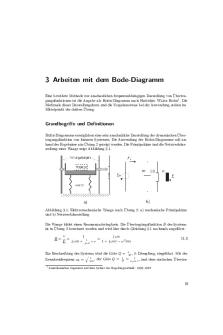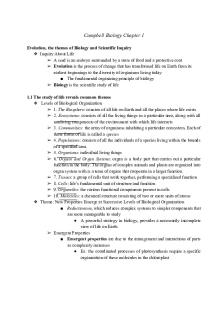Campbell Diagramm PDF

| Title | Campbell Diagramm |
|---|---|
| Course | Introduction to Wind Energy |
| Institution | Technische Universität München |
| Pages | 2 |
| File Size | 110 KB |
| File Type | |
| Total Downloads | 115 |
| Total Views | 174 |
Summary
Diagramm...
Description
Campbell Diagram Explanation Mark Capellaro 17. Dezember 2014 The Campbell diagram is a simple plot of the eigen frequencies of the components and the operational (rotational) frequency of the turbine.
DR A
T
Every component of a wind turbine has its own eigen frequencies. The ones we generally worry about are the lowest, as these eigen frequencies and shapes have the most energy and can cause the most damage if a resonant condition occurs. The plot below has the component eigen frequencies in colored lines.
Abbildung 1: Campbell Diagramm
The axes
First look at the axes. The ordinate (left hand axis) is labeled with ω [Hz]. The abscissa (bottom axis) is labeled with Ω [rpm]. Note that these are the same, simply different units.
The eigen frequencies
Each component has its own set of eigen frequencies. These frequencies are calculated with either the finite element method, the dynamic simulation code or by testing in the laboratory. The bottommost frequency for all turbines to date is the first tower frequency. This is the natural frequency at which the tower wants to resonate. For a symmetric component like a tower, the eigen frequency should be the same in both directions (fore-aft or side-side). The offset of the mass on the tower top (nacelle) can influence these values and ratio. The next eigen frequency is the blade first flapwise frequency. This is the least stiff direction of the blade in bending and therefore the lowest blade frequency. Note that the blade first flap eigen frequency changes with Ω or rotational speed. This is due to centrifugal stiffening. The next eigen frequency is the blade first edgewise. This also increases a bit but the blade is much stiffer in the edgewise direction (to withstand the fatigue loading and due to the geometry of the blade itself).
1
Further blade eigen frequencies continue with higher frequencies along the plot. Also note the top colored line. This is a collective frequency of the blades (in the flap direction). At this frequency (4.5 [Hz]) the blades collectively flap (in synch). Note that this frequency also increases with rotational speed, so we can assume this collective frequency is the rotor collective in the flap direction.
The operational frequencies These are the easiest to explain, the black lines in the plot above. (Unfortunately the left side of the plot is missing, but we should start at zero on both axes). To create the operational frequency lines for the Campbell diagramm, you simply convert the rotational speed on the abscissa. Create what we call the 1P operational frequency line by simple converting the values on the abscissa to Hz. 1[minute] To convert, divide the RPM value by 60 [seconds]. Example, 12[rpm] · 60[seconds] = 0.2[H z]. You do this for the 1P (once per rotation pulse) and then create multiples of this line. For a three bladed turbine, the 3P line is obviously critical (and the 2P not as important).
DR AF T
So you will get a load (or force or pulse) when operating at 12 [rpm] at 0.2 [Hz] from the 1P and 0.6 [Hz] for the 3P. These can be seen if you measure the accelerations of the turbine in operation.
The range
A turbine has only a distinct operation range. The turbine from the example Campbell diagram above operates from 6 to 18 [rpm] (or 0.1 to 0.3 [Hz]). You are only interested in that range (plus a little bit on each side for out of range operation).
Resonances
If the turbine operates at a given rotational frequency where one of the black lines crosses a component eigen frequency, then the component will resonate at its natural eigen frequency and that will mean in increase in fatigue damage. In this plot in the lecture, I pointed out a clear resonance problem with the 3P rotational frequency. You should be able to find what component has an eigen frequency that crosses the 3P operational frequency at 8 [rpm].
Summation
The Campbell diagram is a tool used by wind turbine engineers to identify potential resonance problems in the operation of the turbine. It can also be used to reverse engineer problems, if you find you have a resonance during operation, you can determine the likely cause by knowing the component eigen frequencies.
2...
Similar Free PDFs

Campbell Diagramm
- 2 Pages

Smith Diagramm erstellen
- 4 Pages

Übung Glaser Diagramm
- 17 Pages

Campbell questions
- 17 Pages

3 Arbeiten mit dem Bode-Diagramm
- 24 Pages

Campbell - curwoke
- 20 Pages

Campbell Biology Chapter 1
- 8 Pages

Campbell 9e PPT Ch06
- 75 Pages

Marketing Ch3 - Gordon Campbell
- 3 Pages

Ch26 - Summary Campbell Biology
- 6 Pages

Chapter 8 (campbell biology)
- 8 Pages

Chapter 12- Midterm 2 (Campbell)
- 30 Pages

Bioquimica Volumen I Campbell Issuu
- 40 Pages
Popular Institutions
- Tinajero National High School - Annex
- Politeknik Caltex Riau
- Yokohama City University
- SGT University
- University of Al-Qadisiyah
- Divine Word College of Vigan
- Techniek College Rotterdam
- Universidade de Santiago
- Universiti Teknologi MARA Cawangan Johor Kampus Pasir Gudang
- Poltekkes Kemenkes Yogyakarta
- Baguio City National High School
- Colegio san marcos
- preparatoria uno
- Centro de Bachillerato Tecnológico Industrial y de Servicios No. 107
- Dalian Maritime University
- Quang Trung Secondary School
- Colegio Tecnológico en Informática
- Corporación Regional de Educación Superior
- Grupo CEDVA
- Dar Al Uloom University
- Centro de Estudios Preuniversitarios de la Universidad Nacional de Ingeniería
- 上智大学
- Aakash International School, Nuna Majara
- San Felipe Neri Catholic School
- Kang Chiao International School - New Taipei City
- Misamis Occidental National High School
- Institución Educativa Escuela Normal Juan Ladrilleros
- Kolehiyo ng Pantukan
- Batanes State College
- Instituto Continental
- Sekolah Menengah Kejuruan Kesehatan Kaltara (Tarakan)
- Colegio de La Inmaculada Concepcion - Cebu


